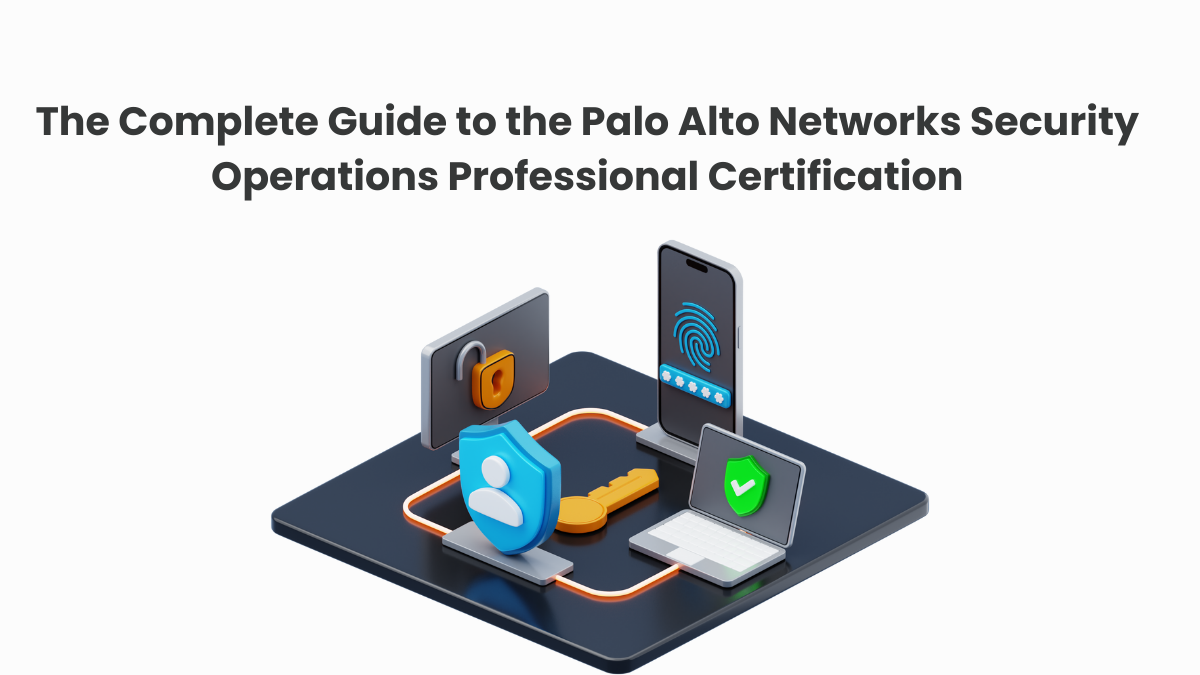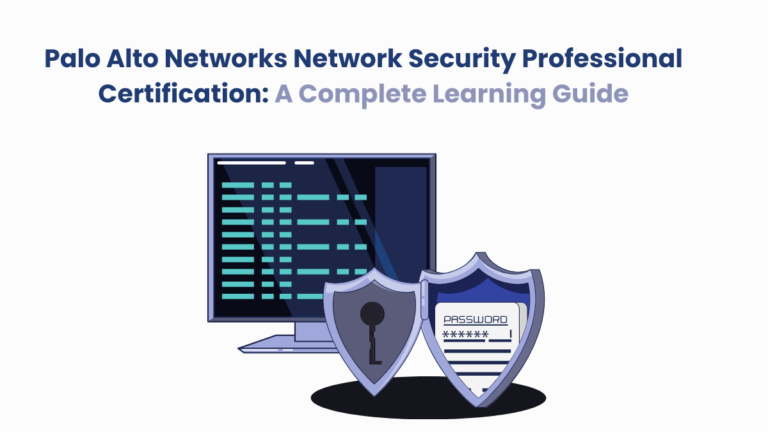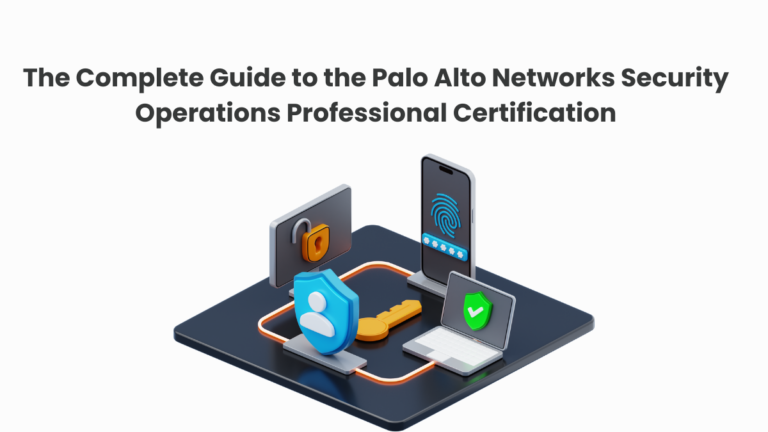If you’re working in a Security Operations Center, chances are you’re juggling too many tools without enough clarity. Tools like Cortex XDR give you one view, XSOAR gives you another, and XSIAM feels like a world of its own.
You’re expected to respond fast, automate smart, and somehow keep everything running smoothly. But half the time, it feels like you’re piecing things together on your own.
If that sound familiar,that’s where the Palo Alto Networks Security Operations Professional certification comes in. The certification can help you get a clear, connected understanding of how Cortex XDR, XSOAR, and XSIAM fit together, and how to use them like a pro.
If you’re ready to stop guessing and start leading in the SOC, you’re in the right place.
Why Take the Palo Alto Networks Security Operations Professional Certification
According to 78% of teams, their security tools are dispersed and disconnected, causing real friction in threat detection and response. This results in slower investigations, missed threats, and overworked analysts.
The Palo Alto SecOps Professional certification is designed to change that. Here’s why it matters and is worth your time:
- Master a Connected Approach to Cortex Tools: Too often, teams use Cortex XDR, XSOAR, and XSIAM separately without understanding how they work together. This certification helps you see the full picture. You’ll learn how to move confidently across tools, streamline workflows, and create a connected response strategy.
- Turn Chaos into Clarity with Proven Frameworks: You’ll dive into MITRE ATT&CK, incident response planning, and Cortex-specific investigation strategies. It’s not just about tools, it’s about applying structure and intelligence to every decision you make on the front lines.
- Get Job-Ready Skills That Actually Apply in the SOC: This isn’t theory. It’s certification is hands-on, practical, and built around real-world tasks. From reviewing incidents to launching playbooks and generating compliance-ready reports, you’ll walk away ready to contribute by the end of your prep. on day one.
- Stand Out in a Crowded Cybersecurity Job Market: With so many security certifications out there, employers are looking for something relevant and focused. This one validates your ability to handle the tools that top-tier SOCs use every day, and that puts you ahead.
Whether you’re just stepping into a SOC role or want to sharpen your edge, this certification gives you what you need to stay sharp, stay fast, and stay ahead.
Palo Alto Networks Security Operations Professional Certification Overview
The Palo Alto Networks Security Operations Professional Certification is built to validate your ability to confidently navigate the Cortex suite in a real SOC environment.
It’s tailored for professionals who want to back up their hands-on experience with a credential that proves they can think critically, respond quickly, and handle incidents with precision.
Here’s a quick look at the essentials:
| Detail | Description |
| Certification Duration | Self-paced learning. The certification exam itself is 90 minutes in length. |
| Delivery Format | Online proctored exam available through Pearson VUE. |
| Certification Level | Intermediate security operations level focused on Cortex technologies. |
| Target Audience | SOC analysts, incident responders, threat hunters, and security operations professionals responsible for monitoring, investigating, and responding using Cortex XDR, Cortex XSIAM, and Cortex XSOAR. |
| Prerequisites | Familiarity with SOC workflows and basic experience with threat detection, incident response, or operation of Cortex tools is recommended. |
Who This Certification Is For
If you spend your day inside a SOC, or you’re preparing to step into one, this certification is built with you in mind. It’s for professionals who want to strengthen their ability to detect, investigate, and respond using the Cortex platform without feeling lost between tools or overwhelmed by daily operations.
You’ll benefit from this certification if you are working as a:
- Security Operations Center Analyst
- Incident Responder
- Threat Hunter
- Security Operations Engineer or Specialist
- Cybersecurity Professionals Moving Into SOC Roles: If you’re transitioning from IT, network security, or general cybersecurity, this certification helps you build the job-ready skills employers expect in modern security operations.
Whether you’re early in your SOC journey or deep into day-to-day investigations, this certification gives you the clarity, structure, and confidence to perform at your best.
Prerequisites
There are no mandatory prerequisites to take the Palo Alto Networks Security Operations Professional certification exam.
However, candidates are expected to have foundational knowledge of security operations and practical exposure to SOC environments.
Recommended background includes:
A. Hands-on experience with:
- Basic investigation workflows inside Cortex XDR, Cortex XSOAR, or Cortex XSIAM
- Reviewing alerts, incidents, dashboards, and reports
- Handling common indicator types such as IPs, hashes, domains, and URLs
- Executing or interacting with automated playbooks during investigations
B. Understanding of security operations concepts such as:
- MITRE ATT&CK tactics and techniques
- Core incident response phases aligned with NIST guidelines
- Behavioral analytics, profiling, and entity classification
- Threat intelligence fundamentals and how they support investigations
C. Operational familiarity with:
- Monitoring, triaging, and escalating alerts in a SOC workflow
- Running searches, queries, and threat hunts using security data
- Using automation and orchestration to streamline tasks
- Working with logs, artifacts, entities, and investigation timelines
While not required, it is recommended that candidates complete foundational-level certifications or training in cybersecurity or SOC operations.
This helps establish the conceptual foundation needed to make the most of this certification and align with real-world SOC environments.
How to Register for the Security Operations Professional Certification
Starting your journey toward the Palo Alto Networks Security Operations Professional credential is simple, and you can begin either through the official Palo Alto Networks certification portal or through an Authorized Training Partner such as Datacipher Education Services.

Source – Palo Alto
Here’s how to enroll –
Step 1. Visit the official certification portal
Begin by accessing the Palo Alto Networks certification website, and browse the certification list. From there you can choose the Security Operations Professional certification to review exam details, topics, and the recommended learning path before scheduling.
Step 2. Open the Pearson VUE testing platform
When you’re ready to book your exam, head to the Pearson VUE page where all Palo Alto Networks exams are hosted. If you’re enrolled with Datacipher, they can help you navigate the registration process.
Step 3. Choose your exam date and time
Pick the schedule that works best for you. This certification exam is delivered through online remote proctoring, allowing you to test from a quiet, secure environment of your choice.
Step 4. Confirm your registration and submit payment
Complete your booking by paying the exam fee. Depending on your region or student status, additional discounts may be available.
You can use Palo Alto Networks’ official learning materials, documentation, and hands-on practice. If you’re preparing with Datacipher, you’ll receive expert-led guidance, scenario-based exercises, and Cortex-focused labs that match the exam blueprint.
At Datacipher, we are an Authorized Training Partner recognized for delivering high-quality, SOC-focused training programs aligned with Palo Alto Networks certifications. Our structured approach, real-world Cortex environments, and mentorship significantly enhance your readiness for the Security Operations Professional exam.
To enroll through Datacipher, visit datacipher.net and reach out to us at training@datacipher.net for more information.
What You’ll Learn in the Security Operations Professional Path
The Security Operations Professional certification focuses on building practical, SOC-ready skills aligned with the five exam domains, listed below.
- Security Operations Essentials
- Threat Intelligence and Response
- Cortex XDR Investigations
- Cortex XSOAR Automation
- Cortex XSIAM Analytics
By the end of this certification journey, you will be able to:
Operate confidently in a modern SOC: You’ll understand SOC roles, log handling, dashboard monitoring, compliance reporting, and how AI or ML-driven detections support faster response.
Investigate and respond with structure: You’ll apply frameworks like MITRE ATT&CK and NIST, work with indicators, analyze alerts, validate true or false positives, and use threat intelligence to guide investigations.
Navigate Cortex XDR like an experienced analyst: From log stitching to causality analysis, behavioral analytics, and agent deployment, you’ll know how to investigate incidents end-to-end with XDR.
Automate repetitive tasks with XSOAR: You will learn how playbooks, integrations, the War Room, and indicator management streamline SOC workflows and reduce manual load.
Leverage XSIAM for large-scale detection and analytics: You’ll work with data ingestion, correlations, automations, BIOCs, advanced search queries, and threat hunting inside a unified analytics-driven platform.
You can refer to this course datasheet for a comprehensive understanding of the training modules.
What You Can Do After This Certification
Once you complete the Security Operations Professional certification, you’ll have a strong operational foundation across Cortex XDR, Cortex XSOAR, and Cortex XSIAM.
A recommended progression is the Palo Alto Networks Cybersecurity Practitioner certification, which builds on your SOC knowledge and introduces deeper technical skills across modern security architectures.
How to Prepare for the Security Operations Professional Certification Exam
Preparing for the Security Operations Professional certification requires a solid understanding of SOC operations, Cortex technologies, and the investigative workflows used in real environments.
This section gives you a focused preparation plan based on the official exam blueprint and the structured training approach offered by Datacipher.
| Feature | Details |
| Type | Multiple-choice, online proctored |
| Duration | 90 minutes with an additional 30-minute ESL extension where applicable |
| Passing Score | Not publicly disclosed, based on scaled scoring |
| Language | English |
| Delivery | Administered online through Pearson VUE |
| Cost | Standard pricing set by Palo Alto Networks; may vary by region |
.
Strategies to Excel in the Security Operations Professional Certification
If you’re aiming to perform well on the Security Operations Professional certification exam, you can use a few focused strategies to guide your preparation. These tips are based on the exam blueprint and Datacipher’s hands-on experience training SOC professionals.
Strengthen SOC Basics (25%): You may find it helpful to review SOC roles, log handling, dashboards, reporting, and how AI or ML supports detection. These fundamentals appear throughout the exam.
Review Incident Response and Threat Intel (16%): You can Study the NIST IR lifecycle, MITRE ATT&CK, IOC types, alert validation, false positives, and intelligence sources like WildFire and Unit 42.
Master Cortex XDR Investigations (23%): You can focus on sensors, log stitching, causality views, behavioral analytics, detection logic, and XDR agent deployment. This domain carries significant weight.
Build Confidence with XSOAR Automation (16%): Looking into playbooks, Marketplace integrations, indicator management, and the War Room can really help you understand how automation reduces manual effort.
Strengthen Cortex XSIAM Knowledge (20%): You might want to practice data ingestion concepts, correlations, automations, BIOCs, entity analysis, and threat hunting queries to build confidence in this area.
Train with an Authorized Partner:If you prefer guided learning, an Authorized Training Partner like Datacipher can provide instructor-led sessions, SOC-focused labs, and scenario-based practice to boost your readiness.
Recommended Study Materials
To prepare thoroughly for the Security Operations Professional certification, candidates should rely on Palo Alto Networks’ official learning resources and documentation. These materials align directly with the exam blueprint and the Cortex technologies covered in the test.
- Certification Handbook: You can start with the official handbook, which outlines the exam structure, domain weightage, key skills, and helpful preparation tips. Download the Certification Handbook here.
- Cortex Learning Resources on PANW Cyberpedia: Cyberpedia is a great place to explore quick articles, visuals, and short videos on Cortex XDR, XSOAR, XSIAM, SOC processes, indicators, and analytics. You can use these resources to strengthen your core understanding at your own pace.
- Palo Alto Networks TechDocs and Knowledge Base: If you prefer deeper learning, you can browse TechDocs and the Knowledge Base for detailed explanations, diagrams, and troubleshooting insights across all Cortex products. These are especially useful when you want more clarity on investigations, playbooks, or automation features.
- Certification FAQ: You can review the official FAQ to clear up questions about exam rules, delivery, scoring, retakes, and certification timelines.
- Learning Path and Resource Center: For structured study, you can follow the digital learning path, which includes guided courses, labs, and on-demand modules aligned with the Security Operations Professional exam. Access the learning path through the Resource Center.
Advance Your SOC Career with Datacipher Education Services
The journey to becoming a skilled security operations professional is much smoother when you have the right guidance. At Datacipher Education Services, we offer a learning experience designed to help you not only pass the Security Operations Professional exam but also thrive in real SOC environments.
- Officially aligned with Palo Alto Networks: As an Palo Alto ATP, we offer training built directly on Palo Alto Networks’ certification standards. We ensure every lesson maps to real exam objectives and current Cortex capabilities.
- Hands-on learning that mirrors real SOC work: With access to live Cortex environments, guided labs, and scenario-driven exercises, you learn by doing. These sessions help you understand how investigations actually unfold, not just how they appear in theory.
- Experienced instructors who support your growth: Each class is led by certified trainers who’ve worked inside SOCs and understand the challenges analysts face. You get personalized feedback, exam strategies, and time to ask questions so you feel fully prepared.
Our approach supports learners at every stage, whether you’re already in a SOC role or transitioning into one with an IT or cybersecurity background.
Here’s what one learner shared about their experience:
“Instructor at Datacipher was a fantastic teacher. He covered all the topics and explained them very well. All questions I had, he had an answer for and not only a verbal answer but he showed me how to do certain things when the question required a visual answer. I highly recommend taking this class with him as the instructor. If I take another class with Datacipher really hoping to get him as the instructor.”
— Becker & Poliakoff, Felipe Gonzalez
If you’re ready to build strong, job-ready SOC skills and prepare confidently for the Security Operations Professional certification, contact us today at training@datacipher.net. Together we can chat your journey for a high paying SOC career.
Frequently asked questions
1. What career opportunities does the Security Operations Professional certification open up?
This certification prepares you for roles such as SOC Analyst Tier 1 or Tier 2, Incident Responder, Threat Hunter, Security Operations Engineer, and Analyst roles focused on Cortex technologies.
2. I already work in IT but not in a SOC. Will this certification help me move into security operations?
Yes. If you have IT experience like networking, system administration, or cloud support, this certification helps you build the investigation and response skills needed to transition into a SOC-focused role.
3. Is the Security Operations Professional certification recognized by employers?
Yes, because it is part of the Cortex certification path, employers view it as a strong validation of real-world SOC capabilities. It is especially valued in organizations that use Cortex for detection and response.
4. Will this certification help me grow in my current SOC role?
Absolutely. The exam reinforces skills like alert triage, behavioral analytics, incident escalation, automation, and threat hunting. These are core competencies that directly impact day-to-day SOC performance and career growth.




